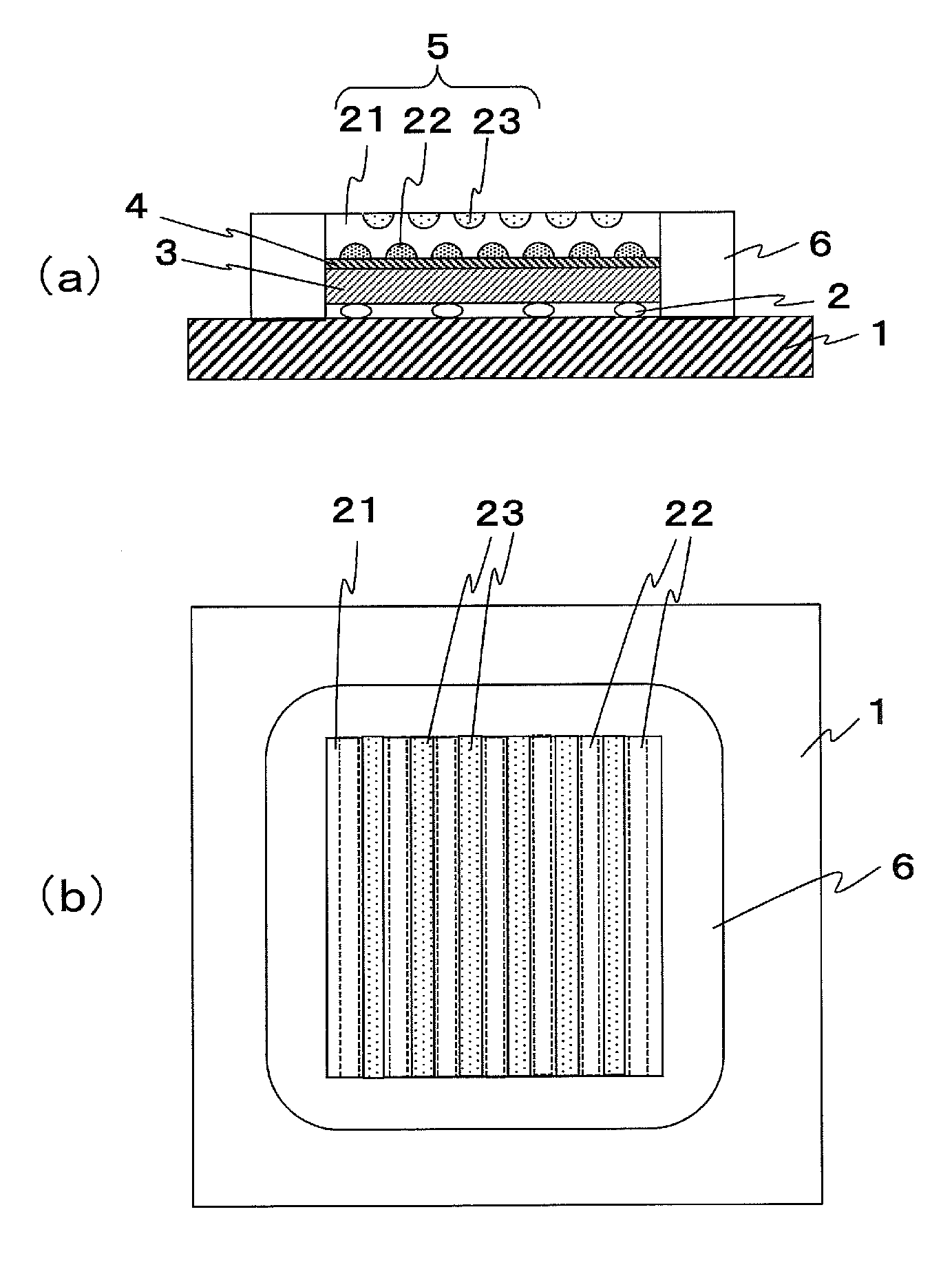Semiconductor light emitting device
a technology of semiconductor light and light emitting element, which is applied in the direction of discharge tube/lamp details, discharge tube luminescnet screen, lighting and heating apparatus, etc., can solve the problems of poor wavelength conversion efficiency, unresolved problems, and inefficient utilization of light output from semiconductor light emitting element as exciting light, etc., to achieve the effect of enhancing light extraction efficiency
- Summary
- Abstract
- Description
- Claims
- Application Information
AI Technical Summary
Benefits of technology
Problems solved by technology
Method used
Image
Examples
first embodiment
[0039]The light emitting device is a device for converting a part of blue light outputted from a blue light emitting flip-chip element, into red light and green light by using a color conversion plate, so as to emit white light which is obtained by mixing the blue, red, and green light.
[0040]FIG. 1(a) illustrates a sectional view and FIG. 1(b) illustrates atop view of the light emitting device according to the first embodiment. As shown in FIG. 1(a), a flip-chip type semiconductor light emitting element 3 is implemented using Au bumps 2 on a substrate 1 on which electrode and wiring are formed in advance. On the semiconductor light emitting element 3, there is mounted a color conversion plate 5 via a transparent adhesion layer 4. Side surfaces of the semiconductor light emitting element 3 and the color conversion plate 5 are surrounded by an optical reflection frame 6.
[0041]The flip-chip type semiconductor light emitting element 3 includes, though not illustrated, an element substr...
second embodiment
[0067]The light emitting device will be explained with reference to FIG. 5(a) and FIG. 5(b). In the light emitting device as shown in FIG. 5(a) and FIG. 5(b), a semiconductor light emitting element 53 which emits blue light is implemented on the substrate 1 where electrode and wiring are formed in advance, by using AuSn eutectic 57 and Au bonding wire 56. The color conversion plate 5 is bonded on the semiconductor light emitting element 53 via the transparent adhesion layer 4.
[0068]The semiconductor light emitting element 53 includes an element substrate and a light emitting layer formed thereupon. The element substrate is a metal bonding (Metal Bonding: MB) element which is opaque to blue light. Hereinafter, in the present embodiment, the semiconductor light emitting element 53 is referred to as MB element 53. The MB element 53 is bonded to the substrate 1 by die bonding via AuSn eutectic 57, allowing the element substrate to face the substrate 1 and the light emitting layer to fa...
third embodiment
[0086]The blue light outputted from the light emitting element 3 passes through the color conversion plate 5, whereby a part of the blue light is converted into red fluorescence and green fluorescence as shown in FIG. 10. In addition, a part of the blue light directly passes through the transparent region 21, or transmits without absorbed by the red phosphor region 22 and the green phosphor region 23. By mixing those light elements, white light is obtained. Such operations as described above are the same as that of the
[0087]In the fifth embodiment, the stripe-like red phosphor regions 22 and green phosphor regions 23 are arranged in such a manner as orthogonal to each other, achieving a configuration that quadrangular transparent regions 21 are arranged vertically and horizontally at the positions where the spacing between the red phosphor regions 22 and the spacing between the green phosphor regions 23 superimpose one on another, when viewed from the top of the color conversion pla...
PUM
 Login to View More
Login to View More Abstract
Description
Claims
Application Information
 Login to View More
Login to View More - R&D
- Intellectual Property
- Life Sciences
- Materials
- Tech Scout
- Unparalleled Data Quality
- Higher Quality Content
- 60% Fewer Hallucinations
Browse by: Latest US Patents, China's latest patents, Technical Efficacy Thesaurus, Application Domain, Technology Topic, Popular Technical Reports.
© 2025 PatSnap. All rights reserved.Legal|Privacy policy|Modern Slavery Act Transparency Statement|Sitemap|About US| Contact US: help@patsnap.com



